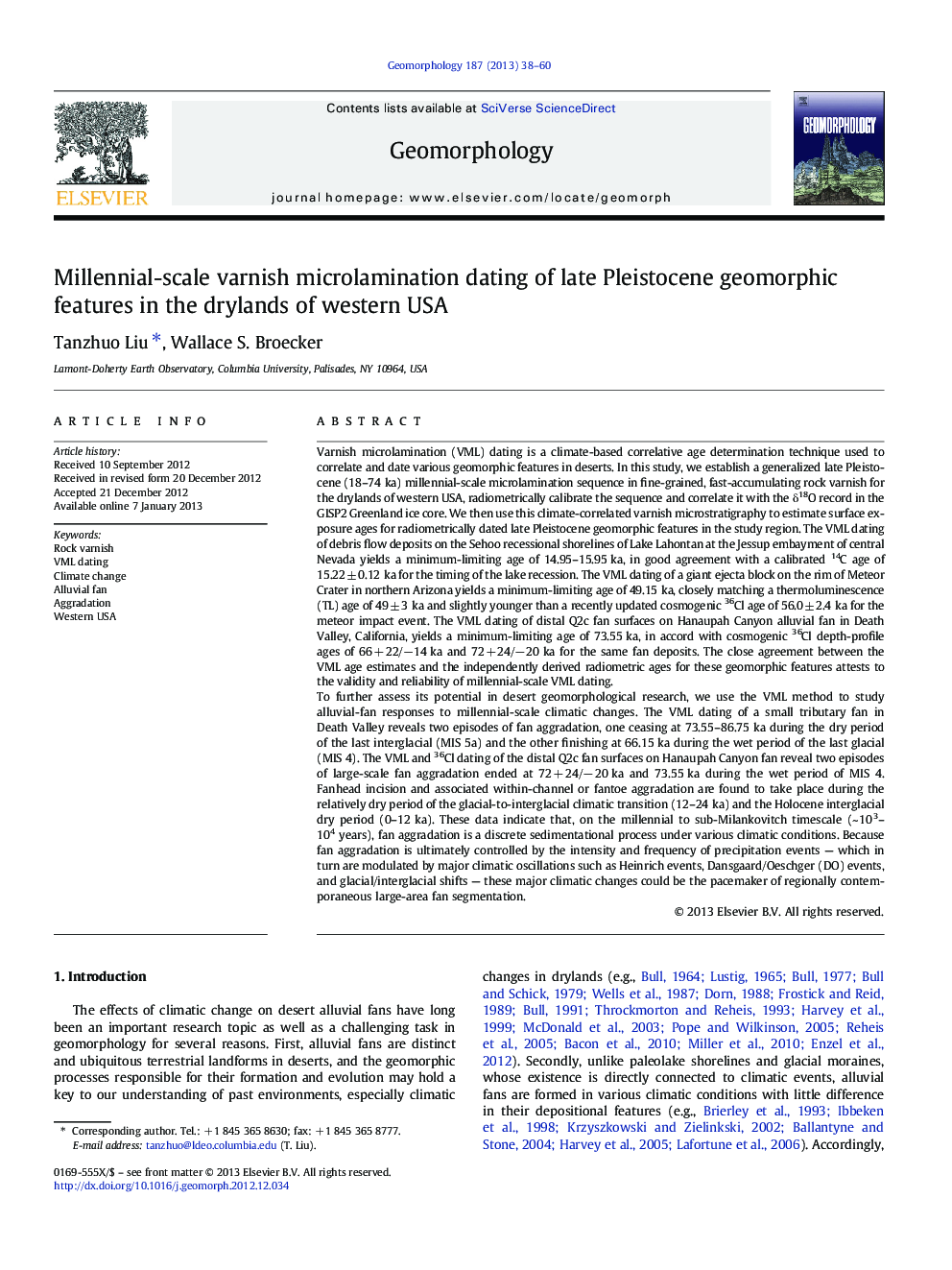| کد مقاله | کد نشریه | سال انتشار | مقاله انگلیسی | نسخه تمام متن |
|---|---|---|---|---|
| 6432835 | 1635462 | 2013 | 23 صفحه PDF | دانلود رایگان |
Varnish microlamination (VML) dating is a climate-based correlative age determination technique used to correlate and date various geomorphic features in deserts. In this study, we establish a generalized late Pleistocene (18-74 ka) millennial-scale microlamination sequence in fine-grained, fast-accumulating rock varnish for the drylands of western USA, radiometrically calibrate the sequence and correlate it with the δ18O record in the GISP2 Greenland ice core. We then use this climate-correlated varnish microstratigraphy to estimate surface exposure ages for radiometrically dated late Pleistocene geomorphic features in the study region. The VML dating of debris flow deposits on the Sehoo recessional shorelines of Lake Lahontan at the Jessup embayment of central Nevada yields a minimum-limiting age of 14.95-15.95 ka, in good agreement with a calibrated 14C age of 15.22 ± 0.12 ka for the timing of the lake recession. The VML dating of a giant ejecta block on the rim of Meteor Crater in northern Arizona yields a minimum-limiting age of 49.15 ka, closely matching a thermoluminescence (TL) age of 49 ± 3 ka and slightly younger than a recently updated cosmogenic 36Cl age of 56.0 ± 2.4 ka for the meteor impact event. The VML dating of distal Q2c fan surfaces on Hanaupah Canyon alluvial fan in Death Valley, California, yields a minimum-limiting age of 73.55 ka, in accord with cosmogenic 36Cl depth-profile ages of 66 + 22/â14 ka and 72 + 24/â 20 ka for the same fan deposits. The close agreement between the VML age estimates and the independently derived radiometric ages for these geomorphic features attests to the validity and reliability of millennial-scale VML dating.To further assess its potential in desert geomorphological research, we use the VML method to study alluvial-fan responses to millennial-scale climatic changes. The VML dating of a small tributary fan in Death Valley reveals two episodes of fan aggradation, one ceasing at 73.55-86.75 ka during the dry period of the last interglacial (MIS 5a) and the other finishing at 66.15 ka during the wet period of the last glacial (MIS 4). The VML and 36Cl dating of the distal Q2c fan surfaces on Hanaupah Canyon fan reveal two episodes of large-scale fan aggradation ended at 72 + 24/â 20 ka and 73.55 ka during the wet period of MIS 4. Fanhead incision and associated within-channel or fantoe aggradation are found to take place during the relatively dry period of the glacial-to-interglacial climatic transition (12-24 ka) and the Holocene interglacial dry period (0-12 ka). These data indicate that, on the millennial to sub-Milankovitch timescale (~ 103-104 years), fan aggradation is a discrete sedimentational process under various climatic conditions. Because fan aggradation is ultimately controlled by the intensity and frequency of precipitation events - which in turn are modulated by major climatic oscillations such as Heinrich events, Dansgaard/Oeschger (DO) events, and glacial/interglacial shifts - these major climatic changes could be the pacemaker of regionally contemporaneous large-area fan segmentation.
⺠Rock varnish record of millennial-scale wetness variations in western USA deserts. ⺠Age calibration and climatic correlation of the varnish record with the GISP2 record. ⺠Using varnish microlaminations (VML) to date late Pleistocene geomorphic features. ⺠Fan aggradation occurs under various climatic conditions based on VML dating results.
Journal: Geomorphology - Volume 187, 1 April 2013, Pages 38-60
